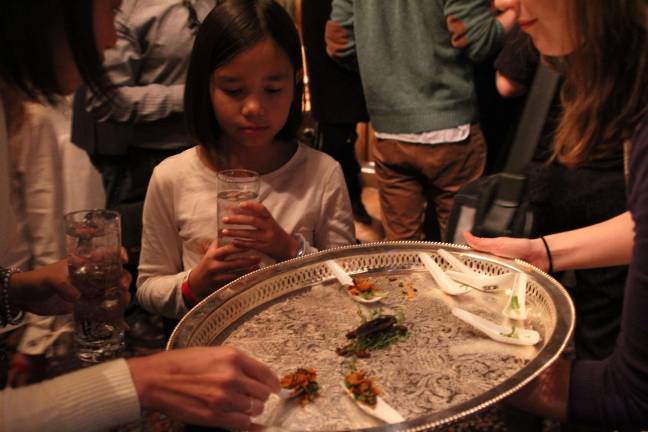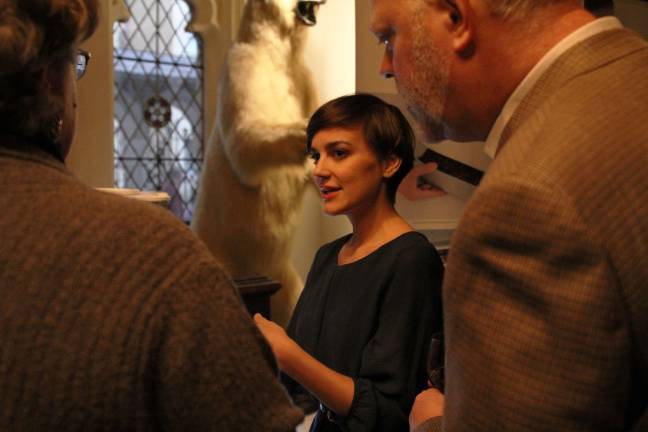High in protein, with a nice crunch




BY NOMIN UJIYEDIIN
The Explorers Club on East 70th Street is known for its affiliation with the first moon landing and the first summit of Mount Everest. But, more recently, the club launched an expedition of a different nature.
At “Crickets and Cocktails,” an event co-hosted by Alimentary Initiatives, the New York Entomological Society and the Metropolitan Society of Natural Historians, guests munched on hors d'oeuvres featuring ingredients that most New Yorkers would be surprised to find on a silver platter.
Cricket croquettes, grasshopper tostadas and waterbug crostini were among the treats, which were prepared by chefs Natalia Martinez and Mario Hernandez. Curious attendees on the club's second floor swarmed around trays of crackers garnished with worms and insects.
New trays, brought out by waiters, emptied in minutes. The line for cocktails wrapped around the wood-paneled room. Side tables featured dishes of dried mole crickets, flying termites and sago grubs, among other critters.
Alexa Saur, 9, liked the crickets and the termites, but not the grubs. Consider her a grasshopper gourmand: she and her 12-year-old sister, Erika, have dined on insects before.
Their mother, Adrienne Saur, has eaten bugs at four other events. She and her husband, Drew Saur, are trying to teach their daughters more about science. “As much as she might enjoy steak, there's a lot more bugs in the world than steak,” Adrienne Saur said.
“We've been looking for an opportunity to expand their horizons,” Drew Saur said, before biting into a breaded croquette featuring manchego cheese, piquin salsa, truffle cream and — of course — crickets.
While the Saur family snacked on the club's balcony, industrial designer Katharina Unger was showing off her latest invention on the second-floor landing. Her company, LIVIN Farms, has developed a desktop hive where consumers can grow their own edible mealworms.
The white plastic hive featured a stack of silver trays, each holding mealworms at different stages of development. The bottom tray was ajar. Hundreds of the inch-long specimens writhed inside it.
Next to the hive, a petri dish held mealworms that were frozen, boiled and roasted. They make for a dry, crunchy snack.
“I just wanted to empower people to grow their own healthy and sustainable food,” said Unger, who was born in Austria and is currently based in Hong Kong. Her travels in Asia and Africa inspired her to explore insects as a source of protein and other nutrients.
“I love it,” she said about the flavor. “What I like about it is that it's a bit nutty but still relatively neutral.”
Unger wasn't always comfortable with the idea of eating insects, also known as entomophagy. “Growing them and seeing how it all works is one of the steps to overcoming the hurdle,” she said. She and her partner, Julia Kaisinger, found that people were more amenable to the idea of eating mealworms once they could see how they were grown.
After the cocktail hour, Unger and other experts presented their perspectives on entomophagy to event attendees who gathered in a room full of Explorers Club memorabilia, including flags that had been brought to Mount Everest and the Marianas Trench.
Aruna Antonella Handa of Alimentary Initiatives, which promotes innovative and sustainable food, lamented that the guests had to try desiccated insects, rather than fresh ones.
“It's the difference between using canned tuna and fresh tuna,” she said.
“From a culinary perspective, they're interesting, but not tasty,” Handa elaborated about the dried insects.
Paleoentomologist Phil Barden explained that the relationship between crustaceans and insects gives crickets their shrimp-like flavor. It's also the reason that people with shellfish allergies might consider avoiding eating the insects, which have been around for 250 million years — longer than dinosaurs.
Crickets are “one of the oldest and most ancient lineages that you've probably ever consumed,” Barden told attendees.
For Lily Berniker and Pam Horsley, this was old news. The two entomologists are no strangers to eating insects with their colleagues. “The trick is convincing non-entomologists that it's a valid food source, and that it tastes good,” Horsley said.
Perhaps the evening's biggest success was that it had.
“Mealworms are delicious,” one afficionado said on the second-floor landing. “I'd love to have mealworm chips.”